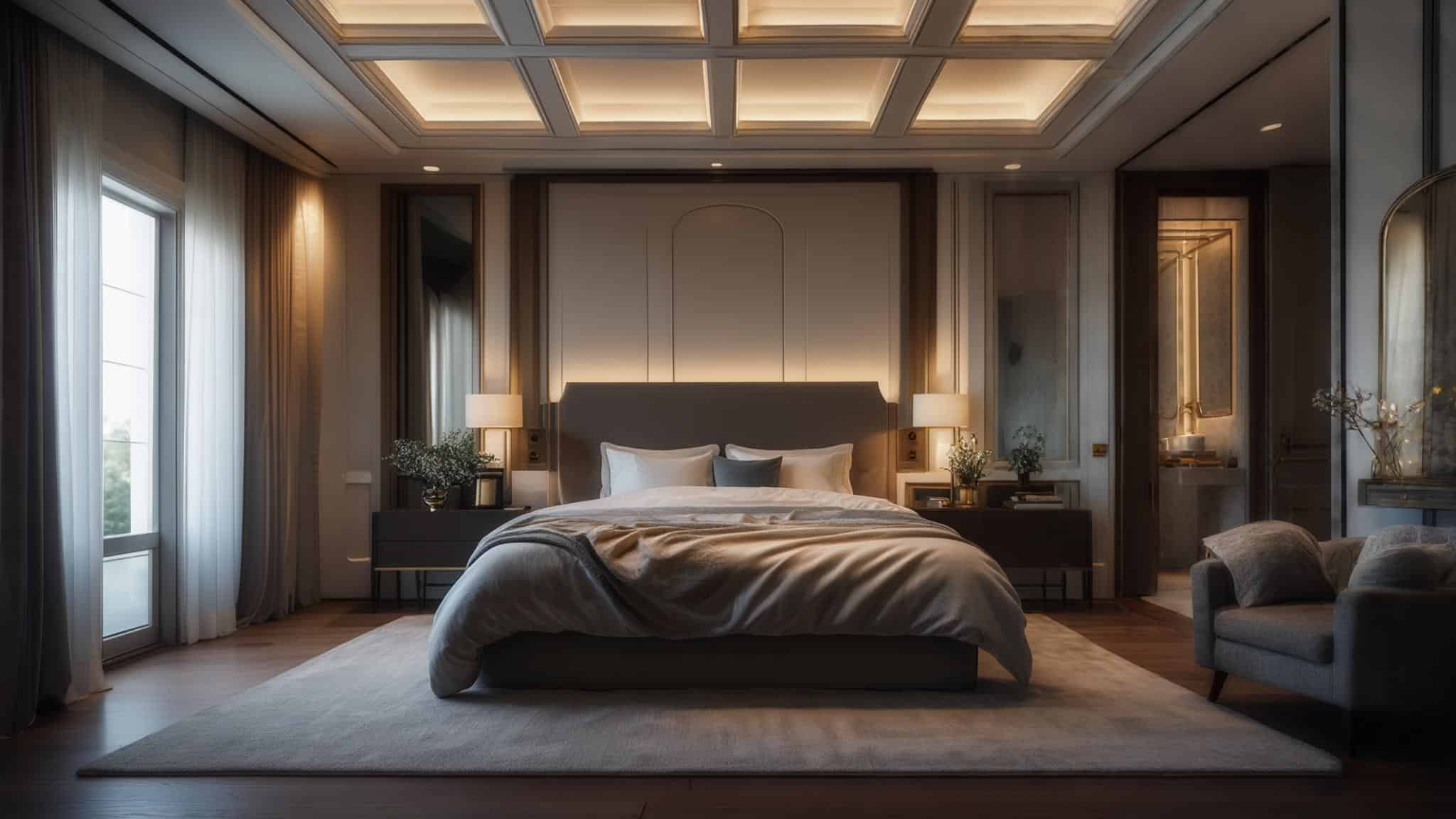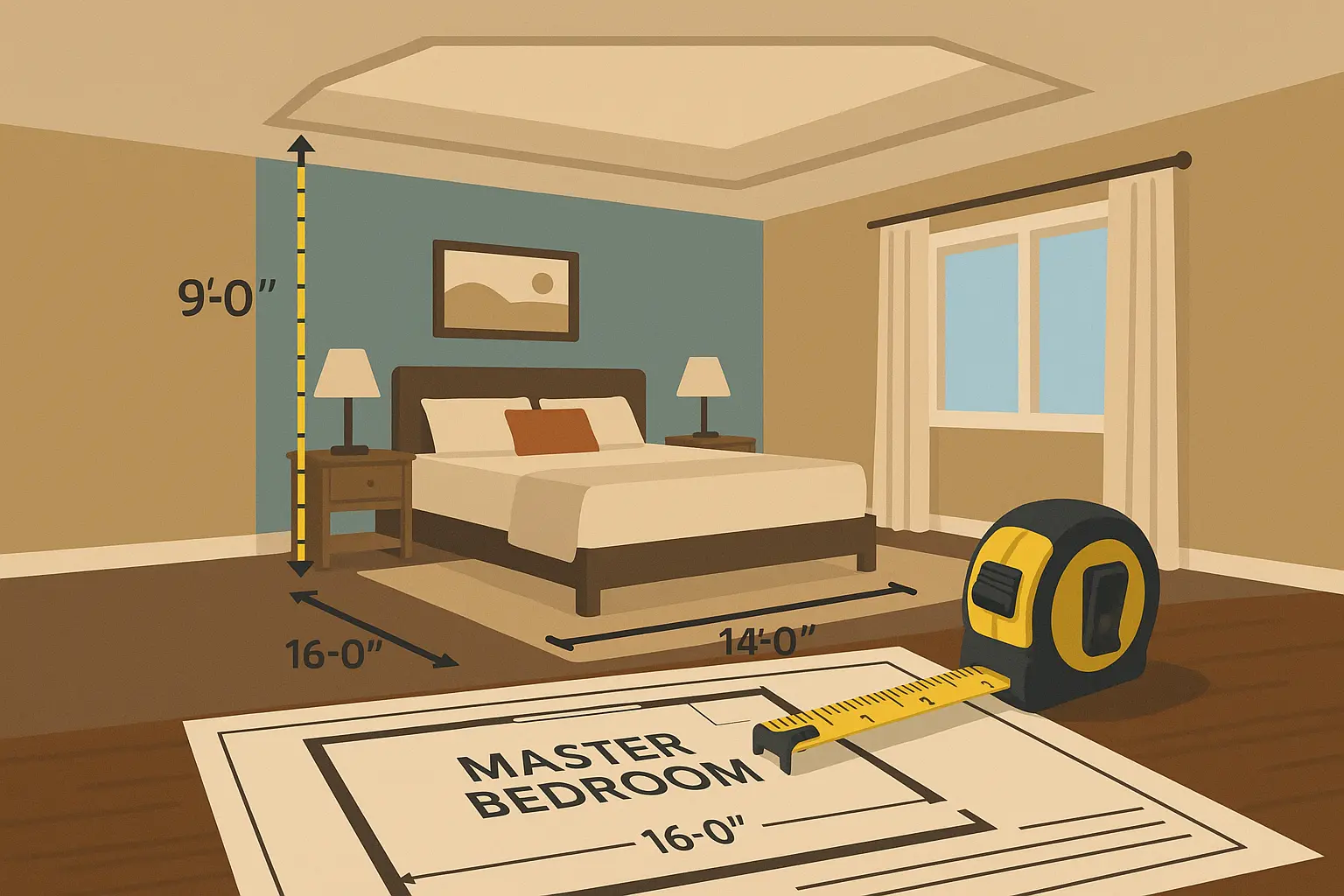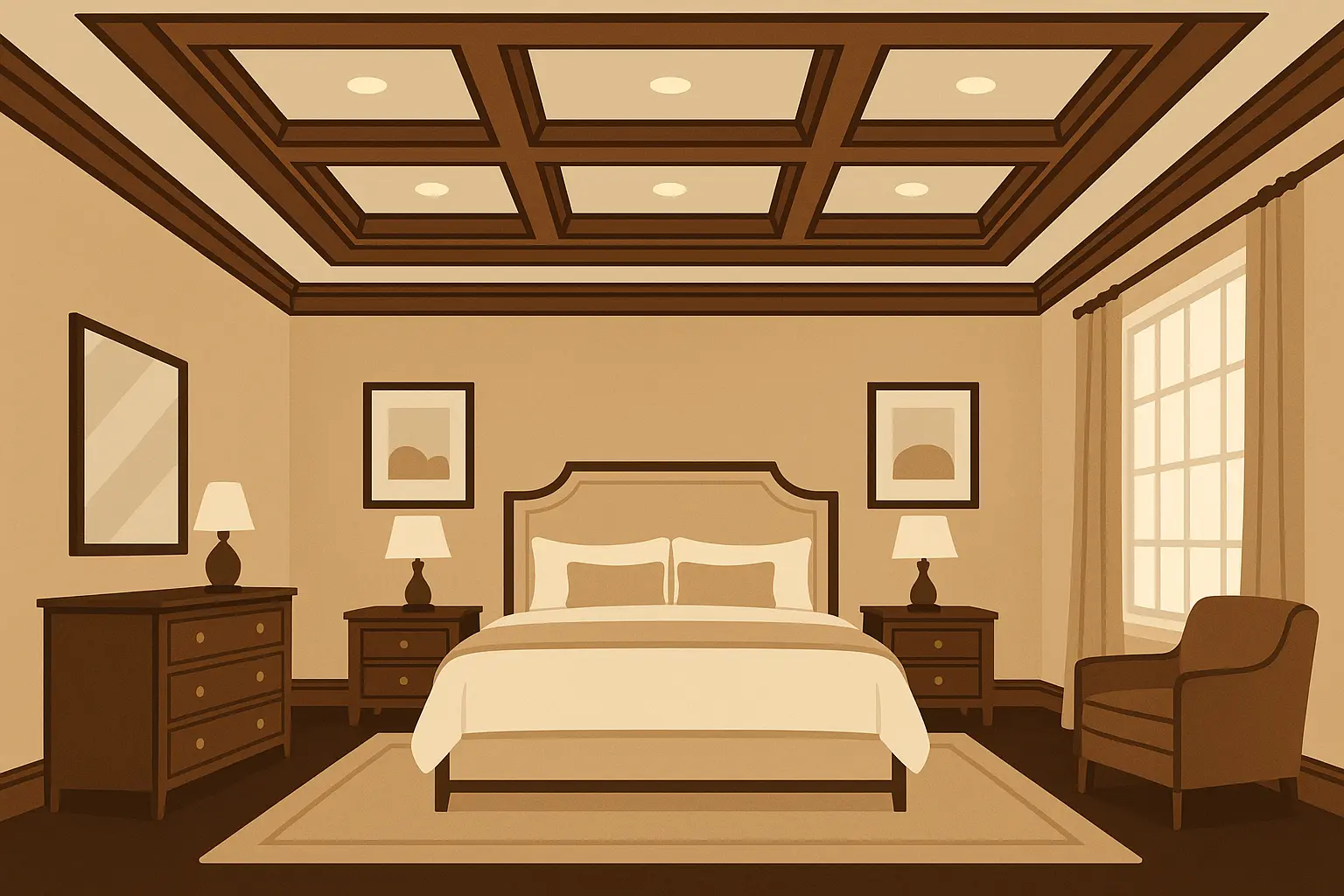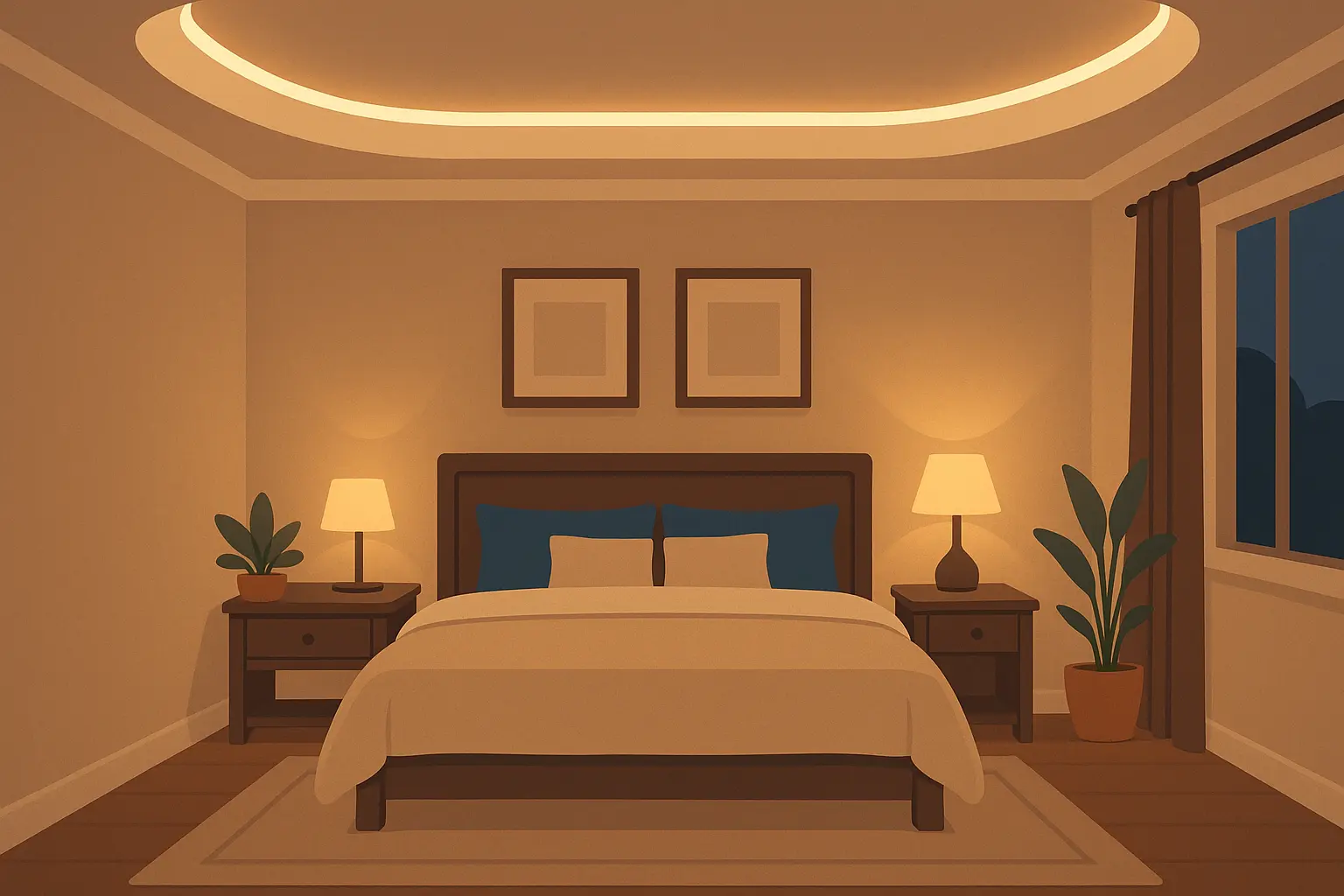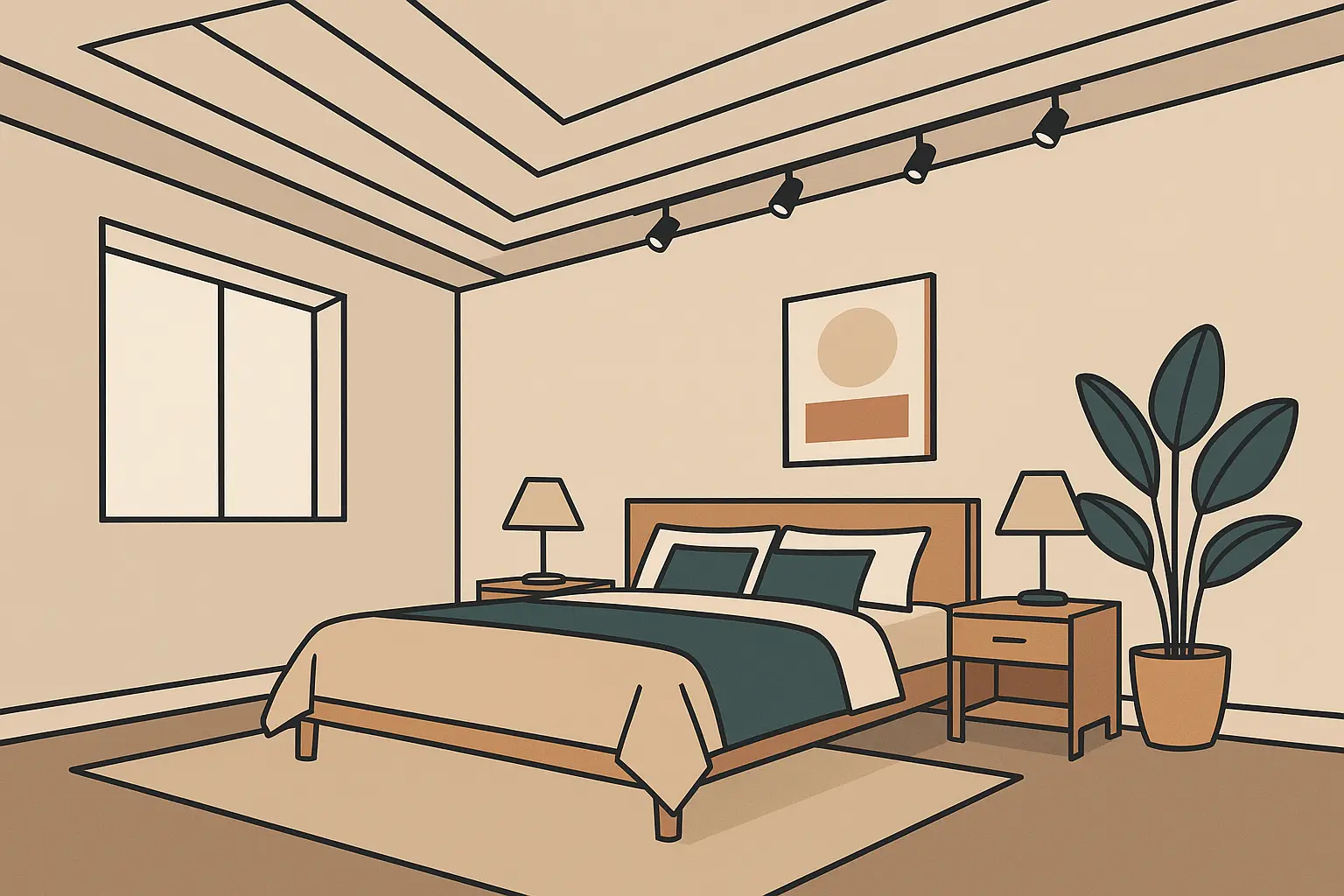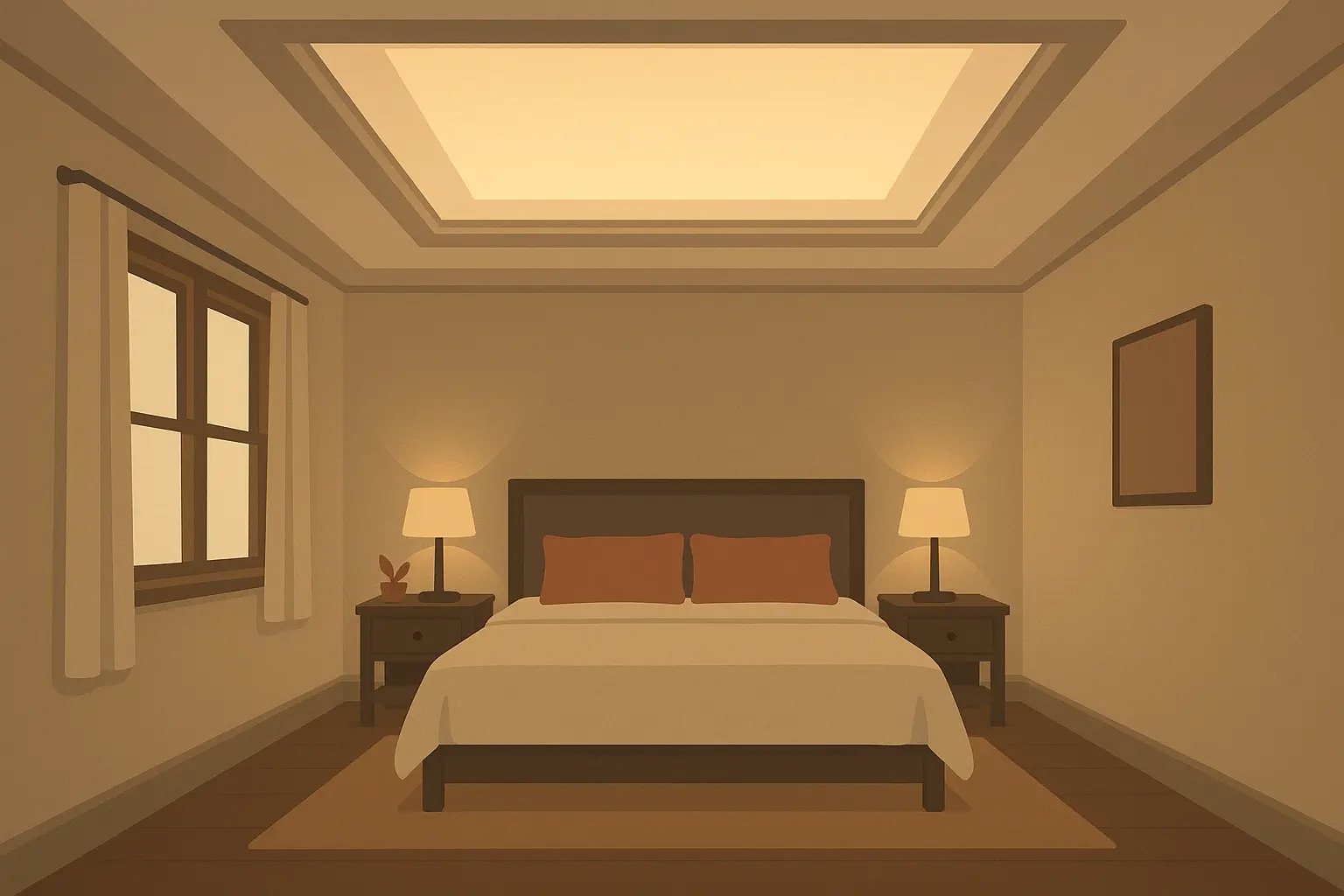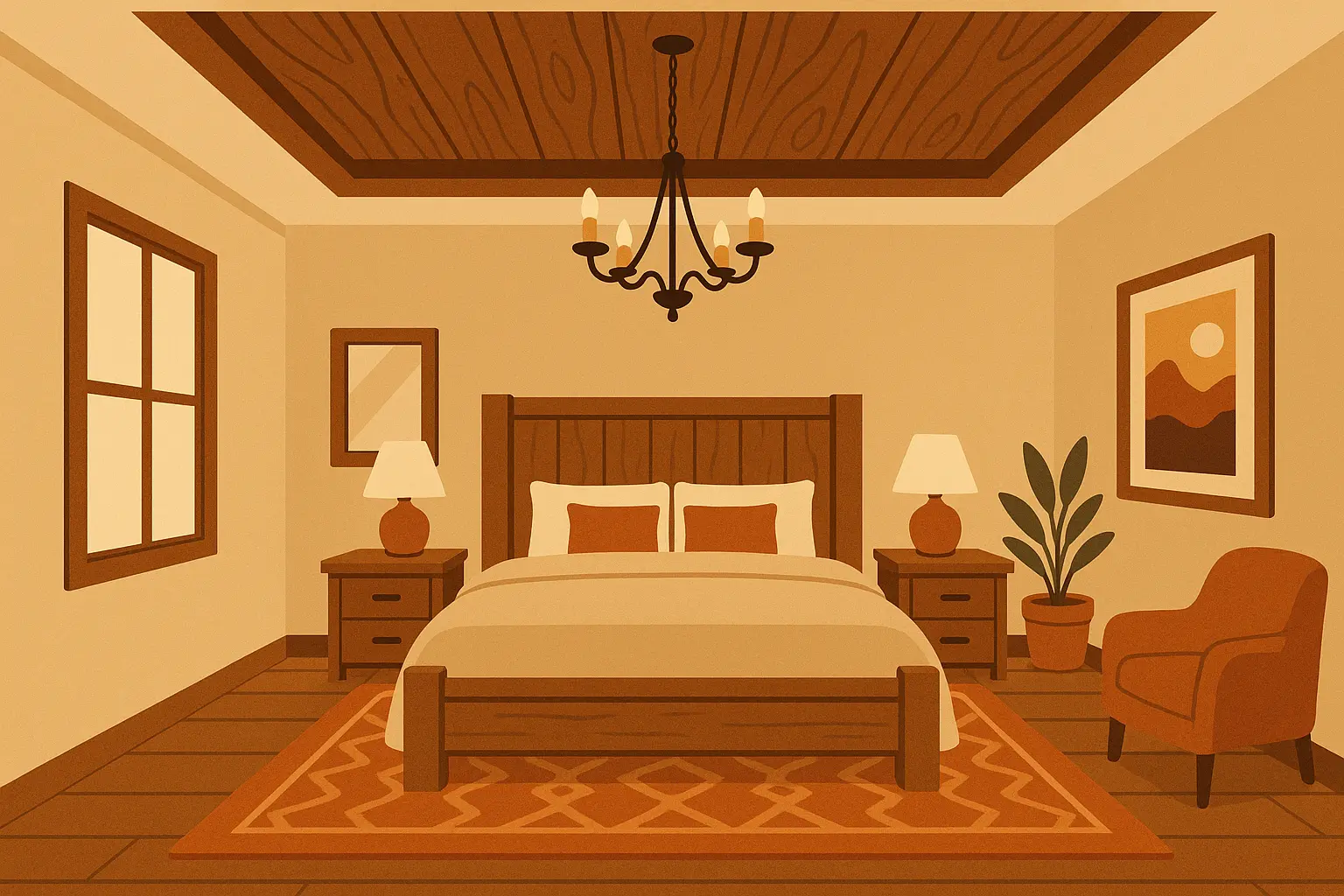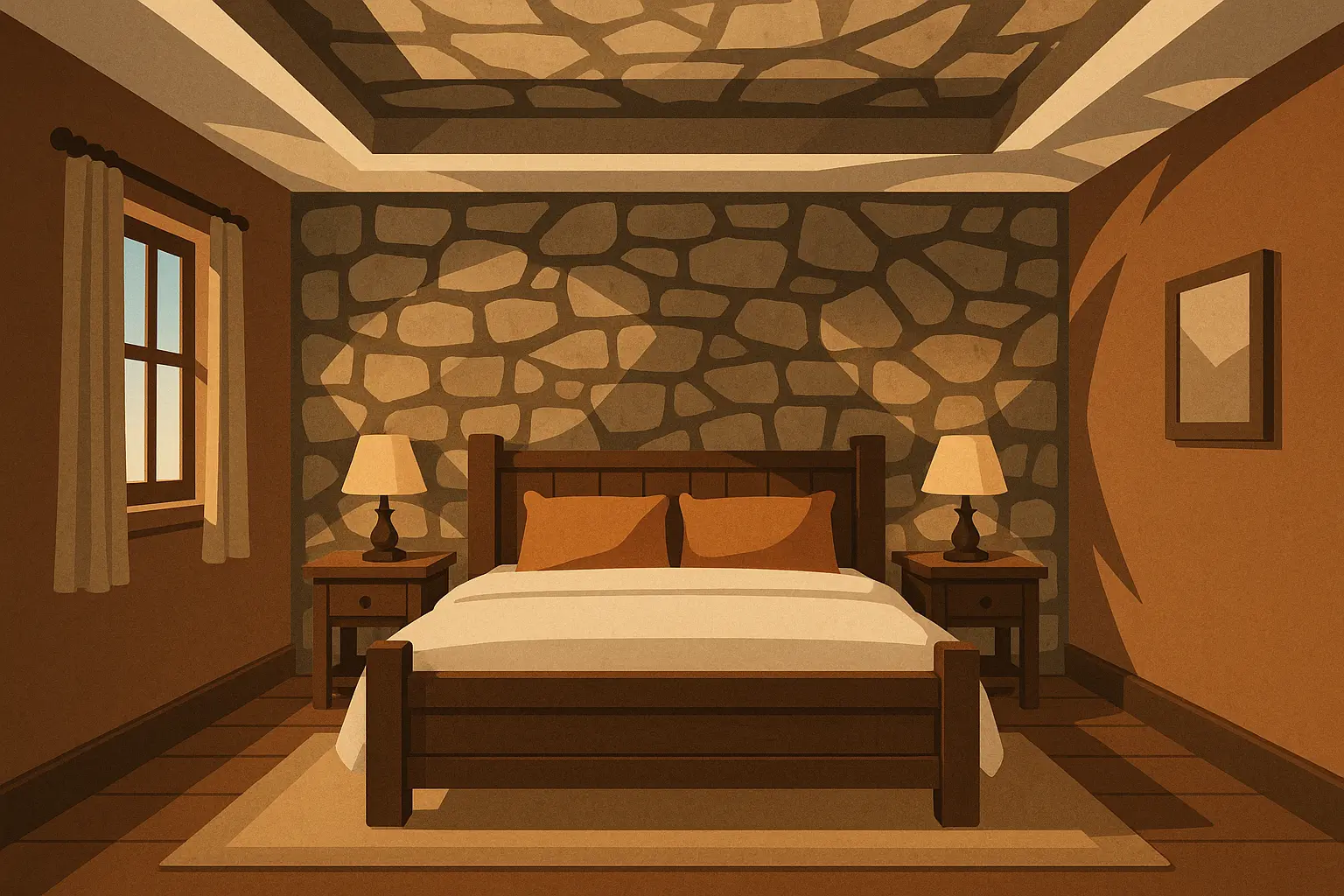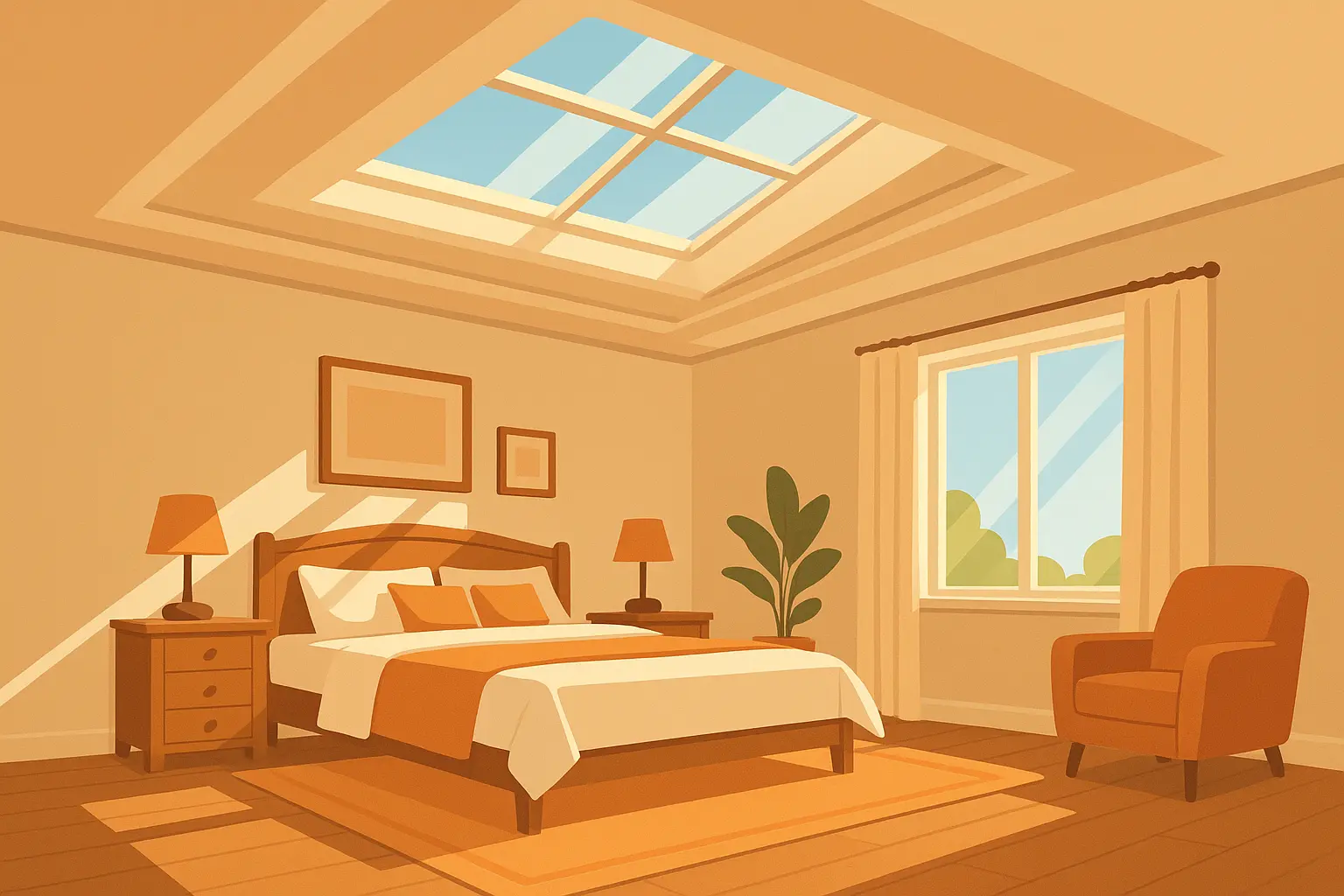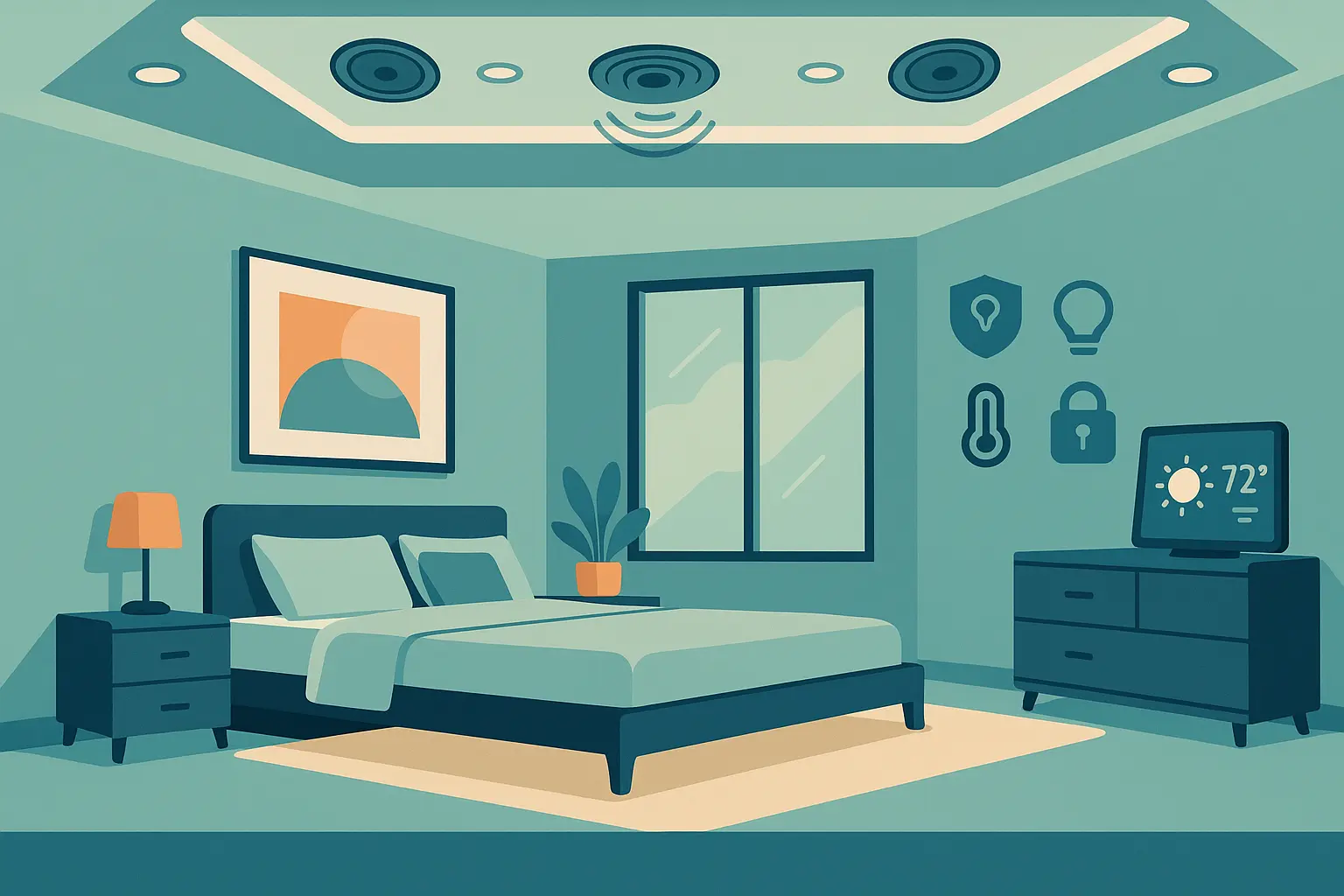25 Master Bedroom Tray Ceiling Ideas That Will Transform Your Space Into a Luxury Retreat
You know that moment when you’re lying in bed, staring at your boring flat ceiling, wondering why your bedroom feels more like a college dorm than a grown-up sanctuary? Yeah, I’ve been there. Then I walked into my friend’s master bedroom and felt like I’d stepped into a five-star hotel suite. The architectural depth, the way the lighting played across different levels, the sheer elegance of it all – I knew I had to figure out how to bring this magic into bedrooms everywhere.
Look, I’ll be honest – I made every mistake in the book on my first tray ceiling project. I thought I could wing the electrical work and ended up calling three different contractors to fix my mess. But after researching dozens of designs, learning from my (expensive) mistakes, and seeing these installations firsthand, I’ve put together 25 tray ceiling ideas that won’t break the bank or your spirit. From simple paint tricks that cost less than a weekend getaway to high-tech smart home setups that’ll make your neighbors jealous, there’s something here for everyone who wants to turn their bedroom into a personal retreat.
Table of Contents
-
What to Consider When Choosing Master Bedroom Tray Ceiling Ideas
-
Classic Elegant Designs
-
Modern Contemporary Styles
-
Lighting-Focused Designs
-
Textured and Material-Rich Options
-
Color and Paint Techniques
-
Unique and Creative Approaches
-
How JiffyJunk Can Support Your Tray Ceiling Project
-
Final Thoughts
TL;DR
-
Here’s the deal – if you can touch your ceiling while standing on your toes, you probably want to keep things simple. If you need a ladder to change a lightbulb, you’ve got more room to play with
-
These projects always cost more than you think – start with your dream number, then add 30%. Trust me on this one
-
Plan your lighting from day one, or you’ll be kicking yourself later when you’re trying to snake wires through finished drywall
-
Classic designs are your safest bet if you’re worried about resale value – they never go out of style
-
Modern options are perfect if you want your ceiling to look like it belongs in a tech magazine
-
Materials matter more than you think – that gorgeous wood might look amazing, but are you ready to dust it regularly?
-
Get help with the construction mess – seriously, don’t be a hero trying to haul drywall scraps yourself
What to Consider When Choosing Master Bedroom Tray Ceiling Ideas
Okay, before you start planning your dream ceiling, let me save you from the headaches I wish someone had warned me about. I’ve seen too many people fall in love with elaborate coffered designs only to realize their 8-foot ceilings would make it look like they’re sleeping in a shoebox.
Your room size basically determines what’s actually possible without making your space feel like it’s closing in on you. You can’t just slap a dramatic deep tray ceiling into a tiny bedroom and expect it to work – trust me, I’ve seen the results, and they’re not pretty.
Room Dimensions and Proportions
If your bedroom is about the size of a standard parking space, stick with subtle designs that add interest without overwhelming the room. I spent three weeks obsessing over coffered ceilings before my contractor gently reminded me that my 8-foot ceilings would make it look ridiculous.
When you’ve got 10+ foot ceilings, that’s when the fun really begins. You can go deep, get dramatic, and add all the architectural bells and whistles that would look silly in a smaller space.
The math is pretty simple. Bigger bedrooms (think 12×14 feet or larger) can handle elaborate designs with deeper recesses and fancy geometric patterns. Smaller spaces need shallow, simple approaches that create the illusion of height instead of eating up your precious ceiling real estate.
|
Room Size |
Ceiling Height |
Keep It Simple |
Go For It |
Budget Reality Check |
|---|---|---|---|---|
|
Cozy (10×12 ft) |
8-9 ft |
Shallow, painted contrast |
Skip the drama |
$800-$2,500 |
|
Just Right (12×14 ft) |
9-10 ft |
Crown molding, gentle curves |
Some depth is fine |
$1,500-$4,000 |
|
Lucky You (14×16+ ft) |
10+ ft |
Why hold back? |
Go nuts with coffers |
$3,000-$8,000+ |
Lighting Integration Planning
Here’s where most DIY warriors get themselves into serious trouble – they design the pretty ceiling first and think about lighting as an afterthought. Don’t be that person. Modern tray ceiling success lives or dies by planning your lighting from day one.
You need to figure out how recessed lights, LED strips, chandeliers, or pendant lights will actually work with your design. The depth and shape of your tray determines what lighting options you’ll have, and this completely changes how your room feels.
Here’s the kicker – running electrical work after your ceiling is done is both expensive and a massive pain. Smart lighting systems need even more planning because you’re dealing with control panels, sensors, and all that connectivity stuff that affects your design and your wallet.
My friend Sarah learned this lesson the hard way in her 14×16 master bedroom. She chose a coffered design with recessed lights in each section, plus LED strips around the edges for mood lighting. By planning the electrical during framing, she saved about $800 compared to trying to add wiring later. Now she can have bright reading light or romantic ambiance with the flip of a switch.
Architectural Style Compatibility
Your tray ceiling should feel like it belongs in your house, not like you copied and pasted it from someone else’s Pinterest board. I’ve walked into homes where someone slapped an ultra-modern geometric ceiling into a 1920s colonial, and it just felt wrong.
Traditional homes usually look best with coffered designs, stepped configurations, or fancy molding that matches the classic vibe you’ve got going elsewhere. Contemporary spaces can handle clean geometric patterns, smooth curves, or minimalist approaches that complement modern design.
You can mix styles if you’re thoughtful about it, but dramatic departures might create that awkward feeling that affects both your daily happiness and what buyers think if you ever sell.
Budget and Installation Complexity
Let’s talk money. Simple painted designs start around $800-$2,000, while fancy molding work or specialty finishes can hit $8,000-$12,000 for the full luxury treatment.
How complex your design is affects both timeline and cost. Basic geometric shapes just need standard framing skills, while curved designs, coffered patterns, or tech integration need specialists who know what they’re doing.
Don’t forget about electrical work, structural changes, and finishing materials when you’re figuring out what this will actually cost. When planning your renovation project, consider how construction debris removal will impact your timeline and budget, because keeping the mess under control helps everything move smoothly.
Maintenance Requirements Assessment
Some ceiling designs are basically “install and forget,” while others need regular attention. Smooth painted surfaces are the easiest – just dust occasionally and touch up paint every few years.
Heavily textured designs, fancy molding, or natural materials? Just know that you’ll be up there with a feather duster more often than you’d like. Dust loves to settle in all those nooks and crannies, especially in designs with multiple levels or complex patterns.
Be honest about whether you want to deal with high-maintenance features before you commit to something that might lose its charm when you realize how much work it takes to keep it looking good.
Resale Value Impact Considerations
Well-done tray ceilings generally add value to master bedrooms, but your design choices make a huge difference in market appeal. Classic, tasteful approaches tend to hold their value better than highly personal or trendy designs that might not click with future buyers.
I once helped a neighbor who painted their tray ceiling bright orange. It looked like a traffic cone. We fixed it, but lesson learned – start with paint samples and maybe run bold choices past a few people first.
Neutral, sophisticated designs with quality materials and professional installation usually give you the best return while letting new owners add their own personality with paint, lighting, or decor.
Classic Elegant Designs
These are the tray ceiling designs that never go out of style – the ones that’ll still look good in 20 years and make buyers nod approvingly when they walk through your bedroom. I’m talking about sophisticated craftsmanship and quality materials that transcend whatever design trend happens to be hot this year.
Each of these classic options works for different room sizes, architectural styles, and budgets while keeping that broad appeal that protects your investment. The focus is on traditional techniques and proven design principles that ensure your ceiling stays stylish long after installation.
1. Traditional Coffered Tray Ceiling
This is the grandfather of tray ceilings – a raised center with decorative wooden beams creating those satisfying geometric panels that add serious architectural depth. It’s the kind of ceiling that makes people look up and say “wow, this is fancy.”
You need a decent-sized bedroom (12×14 feet or bigger) with 10+ foot ceilings for this to really shine. The geometric patterns need space to breathe – cram them into a small room and it’ll feel like the ceiling is pressing down on you. Recessed lights fit perfectly in each coffer section, giving you even lighting that shows off all those beautiful details.
This is definitely a higher-end option, usually running $3,000-$8,000 because of the custom millwork involved. But it’s perfect for traditional, colonial, or craftsman-style homes. You’ll need to dust those beam surfaces regularly, but the long-term value makes it worth the effort for luxury-focused homeowners.
2. Crown Molding Step-Up Design
Think of this as the “gateway drug” of tray ceilings – a simple raised center outlined with elegant crown molding that adds sophistication without overwhelming smaller spaces. It’s like adding a picture frame to your ceiling, but way more impressive.
This works great in medium to large bedrooms with 9+ foot ceilings, and it’s perfect for hanging a central chandelier or ceiling fan in that raised section. The cost is much more reasonable ($1,500-$3,500) depending on how fancy you want to get with the molding.
The smooth surfaces are easy to clean, and this design appeals to pretty much everyone – from traditional to transitional styles. It’s versatile enough that you won’t regret it later, and it won’t scare off potential buyers.
3. Curved Tray with Rope Lighting
Smooth, flowing curves from the outer ceiling to the raised center create these beautiful lines that are enhanced with hidden LED rope lighting. It’s like having a gentle glow emanating from your ceiling – very romantic and sophisticated.
This design works for various room sizes and actually makes smaller spaces feel bigger through the illusion of height. The integrated LED strips eliminate harsh shadows and create that perfect ambient lighting for bedroom relaxation.
It fits with contemporary and transitional styles, running $2,500-$5,000 due to the curved construction complexity. The smooth surfaces are easy to maintain, and the modern lighting features really appeal to buyers who want updated amenities without going full sci-fi.
4. Double-Step Tray Ceiling
This creates two levels of elevation for visual layers and depth, often painted in coordinating colors that enhance the dimensional effect. It’s like having architectural steps leading up to your ceiling’s focal point.
You need higher ceilings (10+ feet) to pull this off without feeling cramped, but those multiple levels give you lots of options for varied lighting placement. The complexity means higher costs ($3,500-$6,000) due to the framing requirements and extra labor.
Multiple surfaces mean more cleaning, but the unique architectural detail adds serious character and value. It’s particularly stunning in formal traditional and luxury contemporary styles.
5. Octagonal Tray Design
An eight-sided raised center adds geometric interest while creating the perfect spot for round or octagonal light fixtures. It’s unexpected enough to be interesting but classic enough to not feel gimmicky.
This works best with adequate ceiling height, and that central area is absolutely perfect for a statement chandelier that becomes your room’s focal point. Costs run $2,800-$5,500 depending on detail level, but you get lasting architectural character.
Those multiple angles need careful dusting, but it’s manageable with regular maintenance. The unique shape appeals to buyers who want distinctive features that set their home apart without being too weird.
Modern Contemporary Styles
Modern contemporary tray ceiling styles are all about clean lines, geometric precision, and innovative materials that create sophisticated bedroom environments. I love how these designs focus on simplicity and functionality while still making a strong visual impact through smart use of space and hidden lighting.
From sharp geometric configurations to industrial-inspired treatments, each option offers unique solutions for homeowners who want cutting-edge design that complements contemporary architecture and modern lifestyle preferences.
6. Geometric Linear Tray
Clean, angular lines create a modern rectangular or square raised section with sharp, defined edges and zero unnecessary frills. This is the “less is more” approach to tray ceilings – architectural precision without any fussy details.
This adapts to various room sizes and creates clean proportions that work beautifully with modern track lighting or linear LED fixtures. The straightforward construction keeps costs reasonable ($2,000-$4,000) while delivering significant visual impact.
Perfect for contemporary, minimalist, or modern farmhouse styles. Simple surfaces are easy to clean and maintain, plus the design appeals to buyers who prefer uncluttered aesthetics that give them flexibility for their own furniture and decor.
7. Floating Panel Tray Ceiling
This creates the illusion of a ceiling panel that’s literally floating in mid-air, with hidden lighting around the perimeter that emphasizes the magic trick aspect. It’s basically the ceiling equivalent of a levitating coffee table.
Works great in medium to large contemporary bedrooms where that perimeter LED lighting creates incredible ambient effects. The investment is higher ($4,000-$7,000) because getting the floating effect to look convincing requires precise construction.
Perfect for ultra-modern and contemporary designs. The smooth surfaces with hidden lighting are low-maintenance, and this really appeals to people who appreciate innovative design solutions and integrated technology.
My buddy Mark installed one of these in his 13×15 contemporary master bedroom. The hidden LED perimeter lighting makes the central panel look like it’s suspended in space. During evening hours, the soft indirect lighting means he doesn’t need bedside lamps, and dimmer controls let him go from bright morning light to romantic evening ambiance. The clean lines work perfectly with his minimalist furniture.
8. Asymmetrical Tray Design
Off-center or irregularly shaped raised sections that break traditional symmetrical patterns and create visual interest through unexpected geometry. This is for people who want their ceiling to be a conversation starter.
Works best in larger rooms where the asymmetry won’t overwhelm the space, and it allows for creative, non-traditional lighting arrangements that enhance the unconventional design. Costs run $3,000-$6,000 due to custom design requirements.
Great for contemporary and artistic interior styles, though those unique angles might need specialized cleaning approaches. This appeals to buyers who want artistic features that create memorable architectural moments.
9. Minimalist Shallow Tray
A barely-there raised center section with clean lines and subtle definition – perfect for people who want architectural detail without visual overwhelm. It’s the whisper instead of the shout approach to tray ceilings.
Excellent for rooms with lower ceilings (8-9 feet) because it adds interest without eating up precious height. Accommodates flush-mount fixtures or recessed lighting beautifully. Lower costs ($1,200-$2,800) make this accessible while still delivering sophisticated results.
Works with Scandinavian, minimalist, and contemporary styles. Minimal maintenance due to simple surfaces, and the understated elegance has broad appeal that protects resale value.
10. Industrial-Style Exposed Beam Tray
Combines raised ceiling sections with exposed metal or wood beams for that urban loft aesthetic that celebrates structural elements as decorative features. It’s like bringing the coolness of a converted warehouse into your bedroom.
You need higher ceilings to accommodate beam depth, and industrial-style fixtures complement the exposed elements perfectly. Costs vary ($2,500-$6,500) depending on beam materials – metal beams typically cost more than wood.
Perfect for industrial, loft, or modern rustic styles. Exposed beams need regular dusting and occasional refinishing, but the character-rich features appeal to buyers who want distinctive architectural elements that create memorable spaces.
Lighting-Focused Designs
These tray ceiling designs put lighting front and center, treating illumination as both a practical necessity and decorative element that transforms ordinary ceiling space into sophisticated lighting systems. I’ve found that these approaches work best when you integrate various lighting technologies – from traditional chandeliers to cutting-edge smart LED systems – directly into the ceiling architecture for seamless, professional results.
Each design tackles specific lighting needs while creating dramatic visual effects that become room focal points. The emphasis on integrated lighting solutions makes these particularly valuable for people who get that proper illumination makes a huge difference in both daily comfort and overall room vibe.
11. LED Strip Perimeter Tray
Hidden LED strip lighting around the entire perimeter creates this beautiful halo effect and ambient lighting that completely transforms your bedroom atmosphere. It’s like having a gentle glow emanating from your ceiling that eliminates harsh shadows and provides adjustable mood lighting.
This works for various room sizes and actually makes smaller rooms appear larger through the visual expansion created by that perimeter lighting. The primary lighting includes dimming capabilities for complete mood control – bright task lighting when you need it, romantic ambient glow when you don’t.
Works great with contemporary and transitional styles, running $2,200-$4,500 including necessary electrical work. LED strips last forever with minimal maintenance, and energy-efficient lighting appeals to environmentally conscious buyers.
12. Chandelier-Focused Medallion Tray
A circular or ornate raised section specifically designed to showcase a statement chandelier as your room’s crown jewel. This is all about creating the perfect stage for luxury lighting that becomes your bedroom’s main attraction.
You need adequate ceiling height so your chandelier doesn’t become a head-bonking hazard (learned this one the hard way), with the central fixture providing primary lighting that can be supplemented by accent lights around the perimeter. Costs run $2,800-$5,200 not including the chandelier, but you’re creating the perfect mounting and display conditions.
Excellent for traditional, transitional, and luxury styles. The medallion details need careful cleaning around fixtures, but luxury lighting features add serious appeal to buyers who appreciate quality craftsmanship and elegant design.
13. Multi-Zone Lighting Tray
Different lighting types within various sections of the tray for layered illumination that handles multiple bedroom lighting needs all at once. It’s like having a professional lighting designer built right into your ceiling.
|
Lighting Zone |
What It Does |
How It Works |
Control Method |
Reality Check |
|---|---|---|---|---|
|
Perimeter |
Ambient glow |
LED strips |
Dimmer switch |
$300-$600 |
|
Center |
Main lighting |
Recessed lights |
Smart controls |
$400-$800 |
|
Accent |
Pretty stuff |
Spotlights |
Individual switches |
$200-$500 |
|
Reading |
Task lighting |
Adjustable spots |
Wall controls |
$250-$450 |
Best in larger bedrooms where multiple lighting zones actually make sense. This provides complete lighting control for reading, relaxation, and general room use. Higher costs ($3,500-$7,000) due to complex electrical requirements, but you get professional lighting design results.
Works with many architectural styles, though multiple light sources mean varied maintenance schedules. Professional lighting design adds luxury appeal that sophisticated buyers appreciate.
14. Backlit Translucent Panel Tray
Translucent materials (glass or special panels) in the tray center with backlighting for this unique glowing effect that creates dramatic focal points. It’s basically like having a giant light box built into your ceiling – sounds weird, looks amazing.
Works in medium to large rooms as dramatic focal points while creating soft, diffused lighting throughout the space. Higher investment ($4,000-$8,000) due to specialized materials and installation requirements, but you get truly unique architectural features.
Best for contemporary and modern designs. Translucent panels need careful cleaning to maintain clarity, but unique features appeal strongly to buyers wanting distinctive elements that set their home apart.
15. Color-Changing Smart LED Tray
Smart LED technology that lets you change colors and program different settings to match moods or occasions. It’s like having a disco in your ceiling, but classier. This tech-forward approach appeals to people who love convenience and customization.
Works for various room sizes, with technology that adapts to space requirements while providing complete lighting control through smartphone or voice activation. Costs run $3,000-$6,000 including smart technology integration and professional installation.
Works best with contemporary and tech-forward designs. Smart systems need occasional software updates, but tech-savvy buyers increasingly appreciate smart home features that offer convenience and energy efficiency.
Textured and Material-Rich Options
These tray ceiling options are all about bringing in tactile elements and natural materials that add serious visual weight and sophisticated character to bedroom environments. We’re talking wood, metal, fabric, and stone elements that add warmth, luxury, and even acoustic benefits while creating distinctive architectural statements.
Each material choice brings its own maintenance requirements and aesthetic qualities that appeal to different design sensibilities and lifestyle preferences. The focus on premium materials and craftsmanship makes these options particularly valuable for people wanting truly custom bedroom environments.
16. Wood Plank Tray Ceiling
Natural wood planks installed in the raised section add warmth and texture, creating that cozy, rustic appeal that brings organic elements into your bedroom. It’s like bringing a little bit of a mountain cabin into your space, but in a sophisticated way.
Works well in medium to large bedrooms where wood’s visual weight won’t overwhelm the space. Warm wood tones complement soft lighting choices beautifully. Costs run $2,500-$5,000 depending on wood type and installation complexity.
Perfect for farmhouse, rustic, and transitional styles. Wood requires periodic cleaning and potential refinishing to keep looking good, but natural materials offer broad appeal and lasting value that resonates with buyers who appreciate authentic, sustainable design elements.
17. Coffered Wood Beam Tray
Combines raised ceiling sections with exposed wooden beams creating geometric patterns and rich texture that screams quality craftsmanship. This is for people who want their ceiling to look like it took serious skill to build.
You need higher ceilings and larger rooms to avoid overwhelming the space. Recessed lights between beams provide excellent illumination that highlights the wood grain and geometric patterns. Higher costs ($4,000-$9,000) due to custom millwork requirements and skilled installation.
Ideal for traditional, craftsman, and luxury rustic styles. Beam surfaces need regular dusting and occasional treatment, but high-end architectural details add significant value that appeals to buyers seeking quality craftsmanship.
My friend Jennifer’s 16×18 master bedroom in her craftsman-style home features a coffered wood beam tray ceiling made from reclaimed oak. The 6-inch deep coffers house recessed LED lights that highlight the wood’s natural grain patterns. The warm honey-colored finish complements her antique furniture perfectly, and the coffered design increased her home’s appraised value by $8,000 – nearly matching the $9,200 installation cost.
18. Metallic Accent Tray Ceiling
Incorporates metallic finishes (copper, gold, silver) in tray sections for glamorous, reflective surfaces that create luxury appeal. It’s like having jewelry for your ceiling – a little goes a long way.
Best in medium to large rooms where metallic elements won’t overwhelm the space. These surfaces reflect and amplify lighting effects beautifully for enhanced ambiance. Costs run $3,200-$6,500 depending on metallic application methods and finish quality.
Works with contemporary, art deco, and luxury traditional styles. Metallic finishes may require special cleaning products to maintain their luster, but luxury finishes appeal strongly to high-end buyers who appreciate premium materials.
19. Fabric-Wrapped Tray Ceiling
Upholstered or fabric-wrapped sections add softness and acoustic benefits while creating luxurious appearances that bring textile comfort into ceiling design. It’s like having a giant padded headboard on your ceiling – sounds strange, feels amazing.
Suitable for various room sizes, fabric additions add coziness to larger spaces while diffusing harsh lighting for softer ambiance. Costs run $2,800-$5,500 including fabric selection and specialized installation techniques.
Works with traditional, transitional, and luxury contemporary styles. Fabric requires regular vacuuming and potential professional cleaning, but unique texture appeals to buyers seeking luxury details that create distinctive, comfortable environments.
20. Stone or Brick Accent Tray
Natural stone or brick elements incorporated into tray designs add substantial texture and visual interest that creates dramatic architectural statements. This is for people who want their bedroom to feel like it has serious architectural heritage.
You need larger rooms and higher ceilings due to visual weight. Stone/brick textures create interesting shadow play with proper lighting placement. Higher investment ($4,500-$8,500) due to material weight and installation complexity.
Excellent for rustic, industrial, and Mediterranean styles. Natural materials may require sealing and specialized cleaning, but they offer lasting appeal and durability that resonates with buyers seeking authentic, substantial architectural features.
Color and Paint Techniques
These are the most budget-friendly ways to create stunning tray ceiling designs while keeping maximum flexibility for personal expression and future changes. We’re talking strategic color placement, gradient effects, and decorative wallpaper that transform ordinary ceiling space into sophisticated architectural features without requiring structural modifications or expensive materials.
Each technique offers different levels of visual impact and maintenance requirements while keeping the ability to update or change designs as your tastes evolve. The emphasis on accessible, reversible design solutions makes these approaches particularly appealing if you want dramatic results within modest budgets.
21. Two-Tone Contrast Tray
Contrasting paint colors between the main ceiling and tray sections create visual depth and definition through strategic color placement. It’s the simplest way to make a big impact – basically like adding a picture frame to your ceiling, but with paint.
Works in various room sizes and can make low ceilings appear higher through proper color contrast selection. Color contrast gets enhanced by proper lighting placement that emphasizes the dimensional differences between ceiling levels.
|
Color Combination |
What It Does |
Best For |
Maintenance |
Reality Check |
|---|---|---|---|---|
|
White ceiling/Gray tray |
Creates depth |
Small-medium rooms |
Easy |
$800-$1,500 |
|
Cream ceiling/Taupe tray |
Warm sophistication |
Traditional styles |
Easy |
$900-$1,800 |
|
Light gray/Charcoal tray |
Modern contrast |
Contemporary spaces |
Easy |
$850-$1,600 |
|
Beige ceiling/Deep brown tray |
Rich warmth |
Rustic/transitional |
Medium |
$1,000-$2,000 |
This works with most design styles and represents the most affordable option ($800-$2,000) using just paint techniques. You might need regular touch-ups over time, but easy color changes appeal to buyers wanting personalization options without permanent commitments.
22. Gradient Color Tray Effect
Subtle color gradation from outer ceiling to tray center creates sophisticated depth and visual flow through expert paint application. This is like having a sunset built into your ceiling – it requires skilled painters but delivers professional results.
Excellent for medium-sized rooms where this creates illusions of expanded space. Gradient effects get enhanced by layered lighting approaches. Costs run $1,200-$3,000 depending on technique complexity and painter skill requirements.
Works well with contemporary and transitional styles. Specialized paint techniques may require professional touch-ups over time, but subtle sophistication appeals to design-conscious buyers who appreciate nuanced, professional work.
23. Wallpaper Accent Tray
Decorative wallpaper applied to tray sections creates pattern, texture, and visual interest as focal points while offering unlimited design possibilities. It’s like having artwork built into your ceiling architecture.
Best in larger rooms where patterns won’t overwhelm the space. Proper lighting showcases wallpaper patterns without creating harsh shadows. Costs run $1,800-$4,000 depending on wallpaper quality and installation complexity.
Pattern selection determines style compatibility – florals work for traditional settings while geometrics suit modern environments. Wallpaper may require careful cleaning and eventual replacement, but neutral patterns maintain broader appeal than bold, highly personal choices.
During your renovation, proper furniture removal becomes essential to protect your belongings and create workspace for contractors installing your new ceiling design.
Unique and Creative Approaches
These tray ceiling approaches push beyond conventional design boundaries to incorporate natural light sources and cutting-edge technology that transform bedrooms into truly innovative living spaces. We’re talking about the pinnacle of modern ceiling design – stuff that combines architectural sophistication with functional benefits that enhance daily living.
Skylight integration brings the outdoors inside while smart home technology creates seamless control over lighting, climate, and entertainment systems. Both approaches require significant investment and professional expertise but deliver unmatched luxury and functionality for people seeking the ultimate in bedroom design innovation.
24. Skylight Integration Tray
Incorporates actual or faux skylights within the tray ceiling design to bring natural light and create open-air feelings that connect your bedroom with outdoor environments. It’s like having a window to the sky built right into your ceiling.
You need adequate ceiling height and structural support for real skylights, while natural light integration reduces dependence on artificial lighting during daylight hours. Higher investment ($5,000-$12,000) for real skylights due to structural modifications, while faux versions cost significantly less.
Works with contemporary, transitional, and modern farmhouse styles. Real skylights require weatherproofing and cleaning maintenance while faux versions need minimal care. Natural light features significantly increase home value and buyer appeal through enhanced living quality.
25. Smart Home Technology Integration Tray
Incorporates speakers, sensors, and smart home technology seamlessly into tray ceiling design for truly modern experiences that integrate entertainment, lighting, and climate control. It’s basically like having your ceiling become mission control for your entire bedroom.
Technology integration adapts to various room sizes with proper planning, while smart lighting systems provide complete control and automation capabilities. Higher costs ($4,000-$10,000) include technology components and professional installation for reliable, integrated operation.
Best suited for contemporary and tech-forward home designs. Systems require periodic software updates and potential technology upgrades over time, but smart home features prove increasingly important to modern buyers who value convenience, efficiency, and integrated technology solutions.
How JiffyJunk Can Support Your Tray Ceiling Project
Let’s be real – tray ceiling renovations create a ton of debris and require careful space management that you probably don’t want to deal with yourself. JiffyJunk handles the messy stuff so you can focus on the fun parts like picking out lighting and admiring your beautiful new ceiling.
When you start a master bedroom tray ceiling renovation, you’ll be amazed at how much junk accumulates. Construction debris from drywall installation, old ceiling materials, packaging waste, and general construction refuse builds up fast during these projects.
Many tray ceiling installations require temporarily or permanently removing bedroom furniture, outdated light fixtures, and existing decor items. JiffyJunk’s careful removal services handle items you no longer need, and their charitable donation program ensures usable furniture benefits local communities instead of filling landfills.
Construction projects keep moving when debris gets removed promptly, creating clean, safe work environments for contractors. Same-day service means construction waste won’t clutter your bedroom space, allowing work crews to operate efficiently and safely throughout installation.
Professional appliance pick-up services become particularly valuable when replacing ceiling fans, outdated fixtures, or HVAC components during your renovation.
Beyond debris hauling, comprehensive cleanup includes sweeping and sanitizing areas after removal, ensuring your renovation space stays clean and ready for each project phase. This attention to detail supports professional installation standards and maintains healthy work environments.
Bedroom renovations involve tons of decisions about design, contractors, and materials that can feel overwhelming. Professional debris removal eliminates major logistical headaches, letting you focus on creating the perfect tray ceiling design for your master bedroom retreat.
For larger renovation projects, consider how estate cleanout services can help clear entire rooms efficiently, creating optimal workspace for your ceiling installation team.
Ready to start your tray ceiling project? Contact JiffyJunk for professional debris removal services that keep your renovation on track and your space clutter-free throughout the entire process.
Final Thoughts
Choosing the right tray ceiling design for your master bedroom comes down to balancing what you love with practical stuff like room size, budget reality, and how much maintenance you’re actually willing to do. The 25 options I’ve shared here offer solutions for every style, ceiling height, and investment level, from simple paint tricks starting around $800 to sophisticated smart home setups that can hit $12,000.
Remember that successful tray ceiling projects depend on planning ahead – especially when it comes to lighting integration, electrical requirements, and structural modifications. Don’t try to figure this stuff out as you go. Professional installation ensures safety and quality results, while proper debris management keeps projects moving smoothly.
When planning your bedroom renovation, don’t overlook the importance of decluttering services to create the clean, organized space that shows off your new architectural feature beautifully.
Whether you choose classic coffered elegance, modern geometric precision, or innovative technology integration, your tray ceiling investment will enhance both your daily living experience and long-term home value. The key is selecting designs that work with your existing architecture while reflecting your personal style and functional needs for years to come.
Consider how professional furniture removal services can help you completely reimagine your bedroom layout, ensuring your new architectural feature becomes the stunning focal point it deserves to be.
A well-designed tray ceiling bedroom creates a luxurious retreat that transforms your daily experience while adding real value to your home investment. Take time to evaluate all your options carefully, plan thoroughly, and invest in quality installation that’ll provide decades of satisfaction in your beautiful new bedroom sanctuary.
